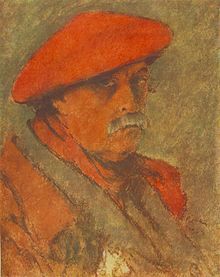József Rippl-Rónai
You can help expand this article with text translated from the corresponding article in Hungarian. (January 2024) Click [show] for important translation instructions.
|
József Rippl-Rónai | |
|---|---|
 Self portrait (1924), Hungarian National Gallery, Budapest | |
| Born | 23 May 1861 |
| Died | 25 November 1927 (aged 66) Kaposvár, Kingdom of Hungary |
József Rippl-Rónai (23 May 1861 – 25 November 1927) was a Hungarian painter. He first introduced modern artistic movements in the Hungarian art.
Biography
He was born in
Later, he returned to Hungary, where critical reception was at first lukewarm, but he eventually had a successful exhibition entitled "Rippl-Rónai Impressions 1890-1900". He believed that, for an artist, not only is his body of work significant, but also his general modus vivendi, even including the clothes he wore. He thus became interested in design, which led to commissions such as the dining room and the entire furnishings of the Andrássy palace, and a stained-glass window in the Ernst Museum, (both in Budapest). Between 1911 and 1913, his exhibitions in Frankfurt, Munich, and Vienna were highly successful. His last major work, a portrait of his friend Zorka, was painted in 1919, and in 1927, he died at his home, the Villa Róma in Kaposvár.
Selected paintings
-
Parisian Woman (1891)
-
My Father and Uncle Piacsek with Red Wine (1907)
-
Studio at Kaposvár (1911)
-
Still-life with Mask (1910)
-
Woman with Three Girls (1909) Brooklyn Museum
References
- ^ Budapest Aukcio
- ^ Horváth János. Rippl-Rónai. p. 9.
Sources
- Horváth János (2007). Rippl-Rónai. Debrecen: Tóth Könyvkereskedés és Kiadó Kft. ISBN 978-963-596-513-7.





